Freestanding vs. Slide-In vs. Front-Control Ranges: Key Differences & Which One to Buy
July 2nd, 2025 | 12 min. read
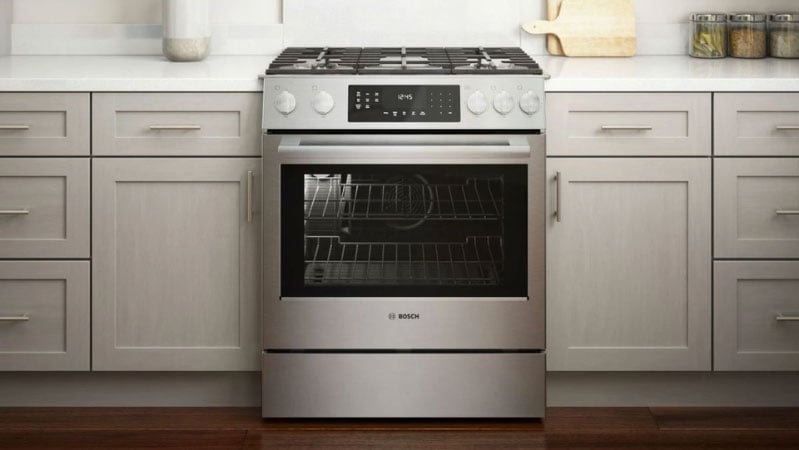
You’ve picked out a sleek slide-in range for your freshly remodeled kitchen in Boston or nearby suburbs like Needham, where I grew up.
The features check every box, and with no backguard, your new tile backsplash finally gets the spotlight it deserves.
Then reality sets in.
The range shows up. It doesn’t fit.
Now what? You either call a countertop specialist to rework your cabinets or start shopping all over again.
This happens more often than you’d think.
Homeowners across Greater Boston run into this problem all the time. Slide-in ranges fall into two very different categories.
While they look nearly identical, their installation requirements are not the same.
In this article, we’ll break down those differences so you don’t end up with the wrong range for your space.
We’ll also show you two backup options, one you might like and one you’ll want to avoid.
Let’s get started.
🎥 Prefer to watch? This video walks you through the differences between freestanding, slide-in, and front-control ranges - and what to double-check before you buy.
Freestanding vs. Slide-In vs. Front-Control Ranges: Key Differences
| Freestanding | Front Control | Slide-In | |
| Controls Location | Backguard | Front | Front |
| Installation | Can go anywhere | Replaces freestanding | Requires custom fit |
| Finished Sides? | Yes | Yes | No |
| Cleanability | Harder to clean around edges | Similar to freestanding ranges | Easier to Clean |
| Best For | Budget-friendly, easy replacements | More modern look, flexible placement | Seamless look, easy to clean |
| Price Range | $599-$1,200 | $999-$2,400 | $1,500-$2,400 |
| Ideal Use Case | Rentals, first-time homeowners, budget buyers | Replacing old freestanding ranges without modifying countertops | New construction, custom kitchens |
What’s the Difference Between Slide-In and Front-Control Ranges?
The biggest differences between slide-in, front-control, and freestanding ranges come down to three things:
- How they’re installed
- Where the controls are located
- How easy they are to clean
Take a look at the examples below. You’ll see an induction slide-in range from Bosch, a front-control range from Café, and a freestanding gas range from LG.

At first glance, the front-control and slide-in models look nearly identical.
That’s where people (but not you) get into trouble.
Only freestanding and front-control ranges have finished sides, so they can go at the end of a cabinet run or up against a wall.
Slide-in ranges need to be tucked between cabinets and overlapped by your countertop.
They might look the same in a showroom, but the installation is very different once they arrive in your kitchen.
Let’s break them down one by one so you don’t end up with the wrong fit.
Freestanding Ranges: Affordable, Flexible, and Easy to Install
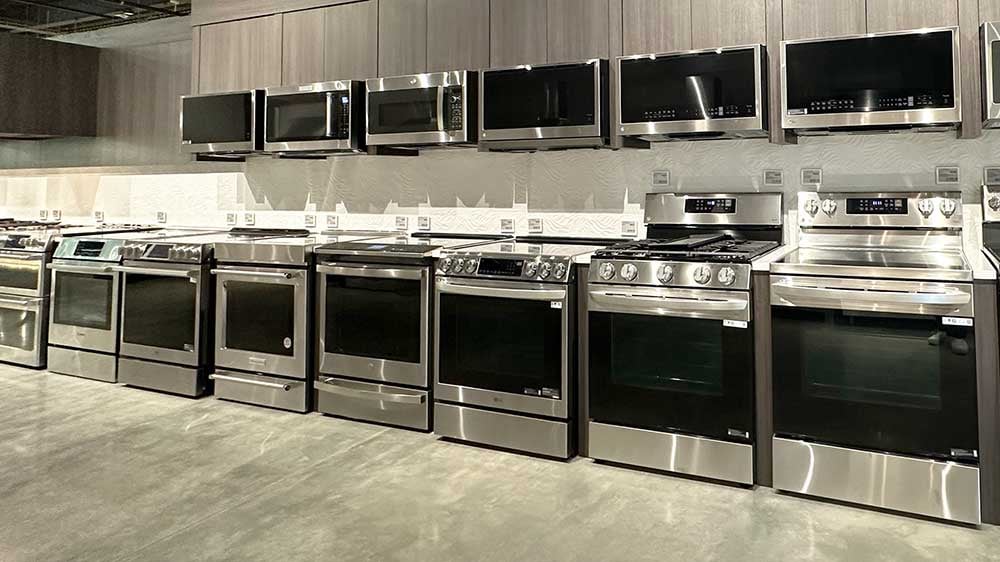
Freestanding ranges are popular in Greater Boston homes.
We see them often in remodels across Greater Boston and even in rental properties down to the Cape because they are simple to install and more budget-friendly.
No need to cut countertops or adjust cabinetry. Just plug it in and go.
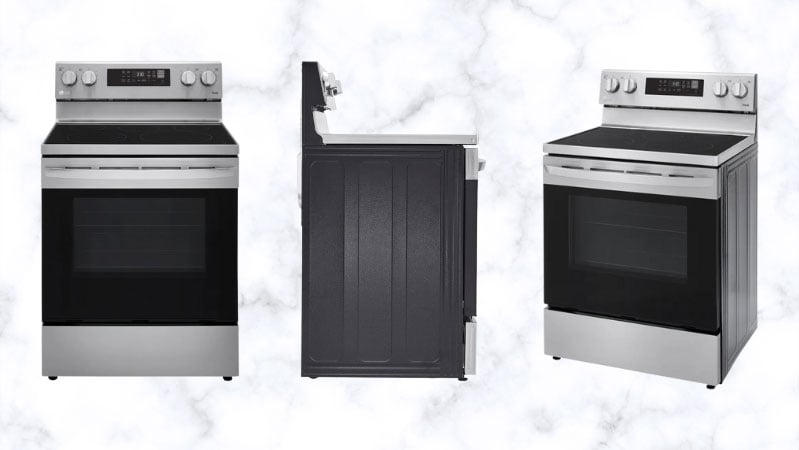
Prices start around $599. That’s a big difference from the $999 or more you’ll spend on a front-control model with similar features.
You’ll also find the most options in this category: gas, electric, or induction.
Dozens of brands. Hundreds of models.
If you're looking for features and flexibility without altering your kitchen layout, a freestanding range is the place to start.
Pros of Freestanding Ranges
- Budget-friendly: Often priced lower than front-control or slide-in models, starting around $599.
- Easy installation: No need to cut countertops or modify cabinetry.
- Flexible placement: Finished sides allow installation anywhere in the kitchen.
- Wide selection: Available in gas, electric, or induction from nearly every major brand.
- Ideal for quick renovations: Great for remodels, rentals, or tight budgets.
Cons of Freestanding Ranges
- The backguard blocks your backsplash. Not ideal if you’ve invested in a statement tile or slab.
- Crumbs and spills can collect between the stove and countertop. It’s harder to keep clean.
- The look is more traditional and may not match modern or custom kitchen designs.
Popular Freestanding Range Brands in Greater Boston

You’ll find freestanding ranges from nearly every major manufacturer. Some focus on value, others on high-performance features.
At Yale, these are the brands we see most often in Boston-area homes:
- GE Appliances – One of the most reliable brands in this category. Available in gas and electric. Good mix of features and value.
- LG – Known for sleek styling and high-output burners. Their ranges are popular in newer condos and mid-level remodels.
- Samsung – Stylish with lots of tech, but we’ve seen higher service rates. Worth a closer look but be cautious.
- Whirlpool & Maytag – Reliable and straightforward. These are common in builder packages across the Cape and South Shore.
- Frigidaire – Budget-friendly with a wide selection. Good for rental units or quick kitchen refreshes.
- KitchenAid – Strong performer in electric and dual fuel. Better fit for homeowners looking for more features without jumping to slide-in pricing.
Looking for something more premium? Most pro-style brands like Wolf, Miele, and Thermador focus on front-control or built-in models instead.
Slide-In Ranges: Seamless Style and Easier Cleanup, but Tricky to Replace
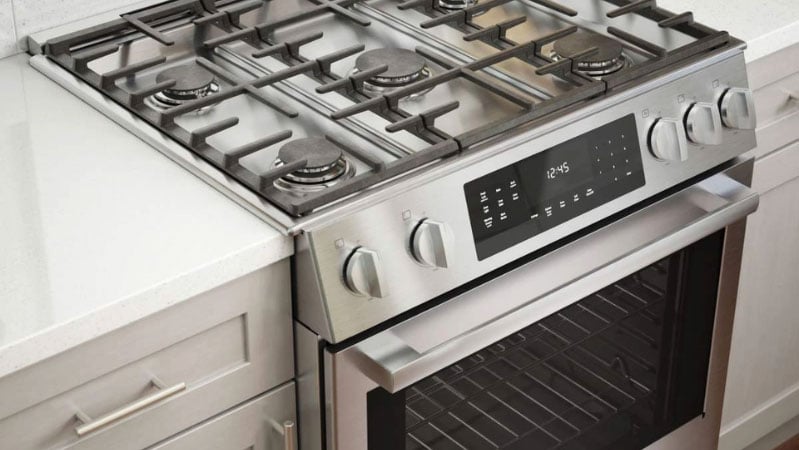
Slide-in ranges offer a built-in look that’s hard to beat.
The sides and back of the cooktop are designed to slightly overlap the countertop, eliminating the gaps where food and spills usually collect.
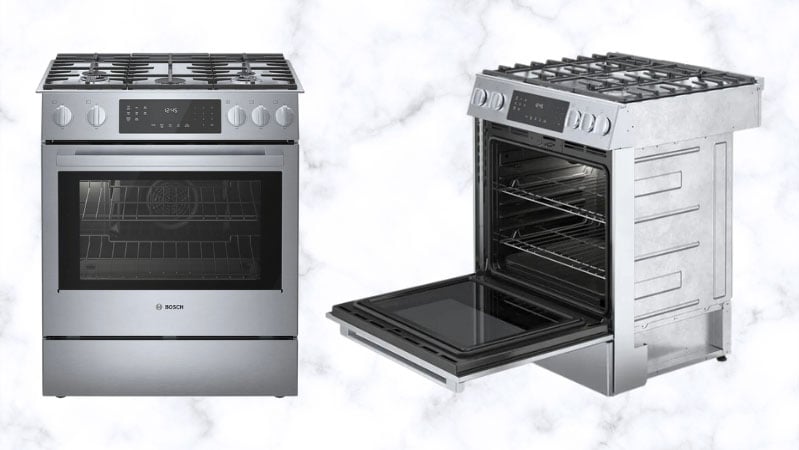 That makes them easier to clean and a favorite in high-end remodels across Greater Boston.
That makes them easier to clean and a favorite in high-end remodels across Greater Boston.
But they’re much trickier to replace, especially if your cabinets and countertops weren’t built to fit one.
Pros of Slide-In Ranges
- Seamless appearance: Countertop overlaps eliminate side and back seams.
- No backguard: Perfect for showcasing statement tile backsplashes.
- Easier to clean: No crevices for crumbs or spills to fall into.
- High-end aesthetic: Common in designer kitchens and luxury remodels.
- Ideal for new construction: Best installed when planned into the layout from the start.
Cons of Slide-In Ranges
- Challenging to replace: Requires a precise cutout and custom cabinet fit.
- Fewer options available: Only a couple of major brands still make true slide-ins.
- Higher starting price: Most models begin at around $1,500.
- Unfinished sides: Cannot be placed at the end of a cabinet run.
Popular Slide-In Range Brands in Greater Boston
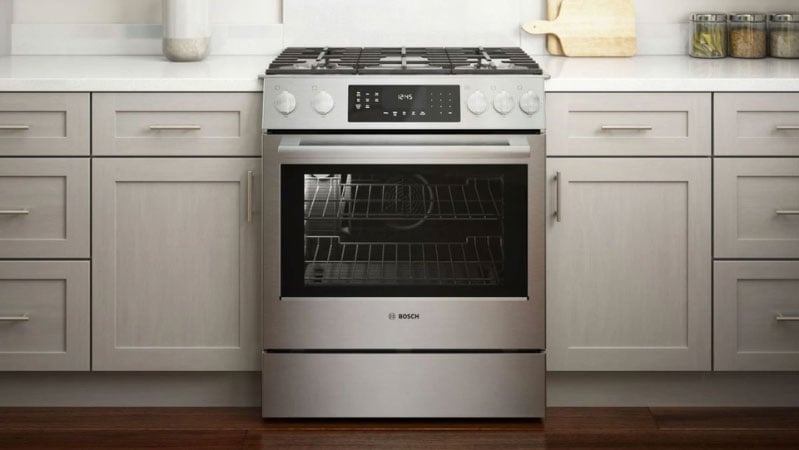
You won’t find many true slide-in models anymore. Only a few manufacturers still offer them, which makes it even more important to understand your options.
- Bosch - Bosch makes some of the best true slide-in ranges available. Their Benchmark and 800 Series models are designed to overlap the countertop for a clean, built-in look. These are a top choice among designers working on older homes where fit and cleanability matter.
Editor’s note: Bosch’s front-control ranges are manufactured by SMEG of Italy.
- Samsung - Samsung still produces a few slide-in models with modern styling and advanced tech features. However, we no longer carry Samsung due to service concerns. If you're considering one, make sure you have reliable support in your area.
These are the only two major brands still committed to true slide-in designs.
Front Control Ranges: Flexible Fit with a Clean, Modern Look
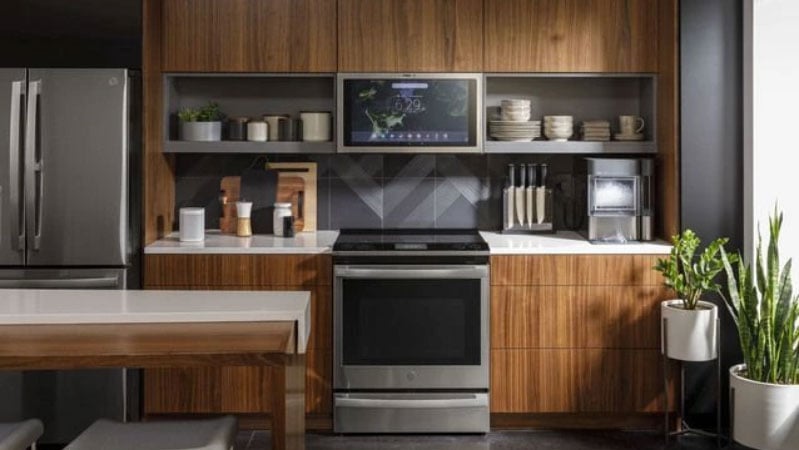
Front control ranges are the most popular style we sell today. They offer the sleek appearance of a slide-in model but install just like a freestanding range.
The sides are finished, so you can place them at the end of a cabinet run, against a wall, or between cabinets without needing a custom cutout.
Homeowners love the clean, modern design.
Builders and remodelers appreciate that they can drop into a standard 30-inch opening without cutting into cabinetry or countertops.
That makes front control ranges a go-to solution in Boston-area remodels where the kitchen layout is staying the same but the style needs an upgrade.
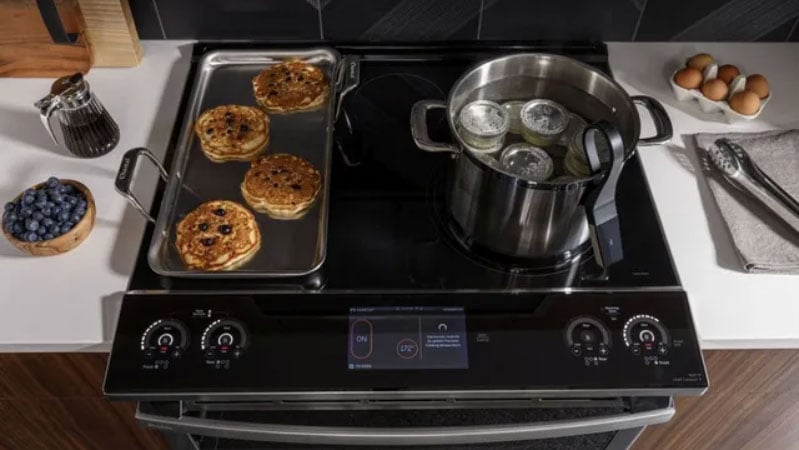
They look almost identical to slide-in models, which is where most of the confusion starts. But the installation process is very different.
If you're replacing an old freestanding range and want something cleaner and more modern without reworking your granite or cabinetry, a front control range is likely your best option.
Pros of Front Control Ranges
- Easy installation: Fits into a standard 30-inch opening with no cabinet or countertop modifications.
- Flexible placement: Finished sides allow installation at the end of a cabinet run or against a wall.
- Modern appearance: Offers a clean look without a bulky backguard.
- Wider selection: Available across all major brands and price points.
- Great for remodels: Ideal when you want to upgrade the style without altering your kitchen layout.
Cons of Front Control Ranges
- Harder to clean than a slide-in: Food can fall between the range and countertops.
- Bumped controls: Burner knobs are easier to accidentally turn on, especially on electric models.
- Not a true built-in: Small side gaps may still be visible unless installed with tight tolerances.
Popular Front Control Range Brands in Greater Boston

- GE Appliances - Reliable and well-supported. Offers gas, electric, and induction options. Popular across all price points, including the Profile and Café Series.
- LG - Stylish with advanced features. Strong performance in convection and high-output burners. Induction front control models are top sellers in our showrooms.
- KitchenAid and JennAir - KitchenAid offers a larger oven cavity at a mid-range price. JennAir models are nearly identical in design and performance.
- Whirlpool and Maytag - Simple and affordable. Common in rentals, multi-unit housing, and budget-conscious remodels.
- Frigidaire and Electrolux - Good value options for quick upgrades or cost-effective projects.
- Samsung - Stylish with smart features, but we no longer carry them due to service concerns. If purchasing Samsung, confirm local service availability.
- Professional Brands (Wolf, Miele, Thermador, SKS, BlueStar) - Nearly all pro ranges are front control by design. These models don’t have a backguard and can fit into most layouts. Just confirm cabinet clearances and venting needs.
Are Front-Control and Slide-In Electric Ranges Fire Hazards?

As I was writing this, LG announced a recall of over 500,000 electric front control ranges.
The issue? Accidental burner activation. That means a burner could turn on without you realizing it.
🎥 Watch Now: LG’s Electric Range Recall Explained
This short video covers the cause of the recall, how it compares to others, and what you can do to stay safe.
Last year, Samsung recalled one million ranges for the same reason. Kenmore added another 200,000 to the list.
And the fix?
Not a part.
Not a repair.
A sticker.
That’s right. LG’s solution is to place a sticker on the range reminding you to shut it off when you’re done. That is their official recall response.
It is worth noting that gas and induction ranges are not part of these recalls.
With gas, you see a flame. With induction, the burner won’t heat unless there’s a pot on it. No metal, no heat.
Electric is different.
A bump, a nudge, or even a cleaning cloth can activate a burner. Then it glows red a few minutes later. By that time, you might already be in another room.
The good news is this is avoidable.
You just have to stay aware. If that feels like a risk in your home, especially with kids or elderly parents, consider an induction or gas range instead.
Or go back to a freestanding model with the controls safely on the back.
Editor’s note: I left my gas cooktop on for hours on a simmer setting. So it can really happen to anyone.
What About Professional Ranges?

Look at any professional-style range priced between $4,500 and $20,000. At first glance, they look like slide-in ranges.
There’s no backguard, and the controls are all up front.
But they are not slide-ins. Every single one is a front control range.
That includes brands like Wolf, Miele, Thermador, BlueStar, and SKS.
They may look built-in, but they install just like a freestanding or front control model. They have finished sides, sit on the floor, and do not require countertop overlap.

It’s an important distinction.
We’ve seen this confuse even seasoned designers in the past.
If you're planning a professional range, make sure you understand the clearance, cabinet spacing, and venting requirements.
These units can be easier to install than slide-ins, but only if you know what to expect.
Bonus #1: What is a Drop-In Range?
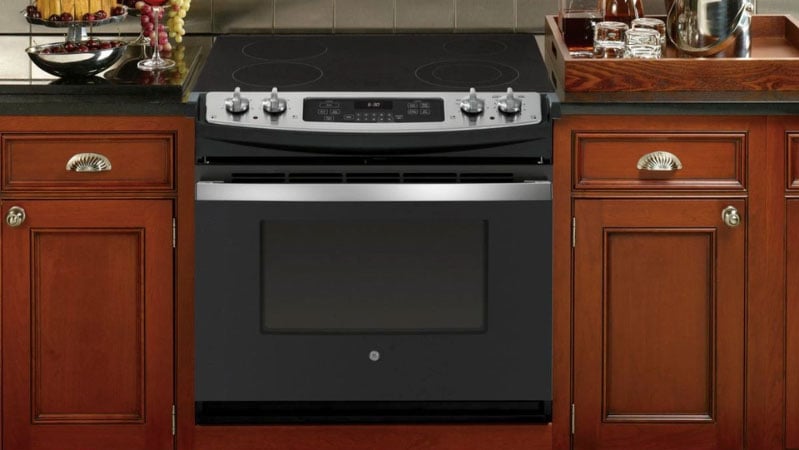
That depends on who is asking.
Some people use the term "drop-in" when they really mean a cooktop.
But a true drop-in range was a popular choice in the 1950s and 60s.
You still see them today in older homes, especially ones built by Campanelli Construction across towns like Dedham, Norwood, Quincy, and Randolph.
A drop-in range rests on top of a base cabinet.
It has no bottom drawer and no visible toe kick cutout. That creates a flush, built-in look from floor to countertop.
It was a clean aesthetic, but not one that fits most modern kitchens.
Today, GE is the only major brand still making a true drop-in range.
If your cabinet is still in good shape and you are just replacing the range, this may be your simplest option.
But most people remove the cabinet and upgrade to a freestanding or front control model instead.
You get more features, more flexibility, and a much better selection.
Bonus #2: Cooktop Over Wall Oven
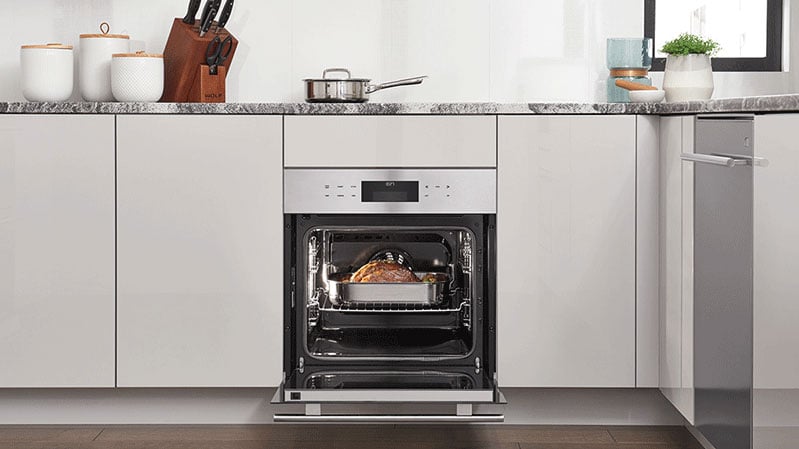
If you like the built-in look of a drop-in range but want something more modern and functional, consider pairing a cooktop with a wall oven.
This setup gives you the most design flexibility.
You can choose a gas, electric, or induction cooktop and match it with any wall oven you like. Brands do not have to match.
You can prioritize performance, features, or design.
It is also one of the cleanest setups you can install. There are no seams between the appliance and the countertop.
Just like a slide-in range, this helps keep crumbs and spills from falling through the cracks.
It does come at a higher cost.
A cooktop and wall oven combination usually costs hundreds or thousands more than a freestanding or front control range.
But the result is a high-end, seamless look that works beautifully in custom kitchens.
If you are working with a designer or building from scratch, this is one of the best ways to personalize your cooking space.
Front-Control vs. Slide-In: Which One Should You Choose?
If you're not going with a freestanding range, the choice usually comes down to front control or slide-in. Here's how to decide based on what matters most to you:
✅ Want more brand options?
Choose a front control range.
Most manufacturers offer front control models, including pro-style brands. You’ll have more choices, especially if you're looking for induction or dual fuel.
✅ Want the easiest range to clean?
Go with a slide-in range.
The cooktop overlaps the countertop, so there are no seams along the sides or back. Spills stay contained, and crumbs won’t fall between the range and the counter.
✅ Replacing an old range without changing cabinets?
Front control is your safest choice.
It fits a standard 30-inch opening and doesn’t require cabinet or countertop modifications. Perfect for existing kitchens in areas like Milton or Belmont.
✅ Installing at the end of a cabinet run or near a wall?
Choose a front control or freestanding range.
These models have finished sides and look clean from any angle. Slide-in ranges have unfinished sides and must be installed between cabinets.
✅ Want a modern, built-in look for a new kitchen?
Slide-in ranges offer the cleanest visual integration.
There’s no backguard or visible gaps. Just a smooth transition from countertop to cooktop—ideal for custom or high-end renovations.
Installation and Replacement: What to Know Before Upgrading Your Range
How Do You Replace an Old Slide-In Range?
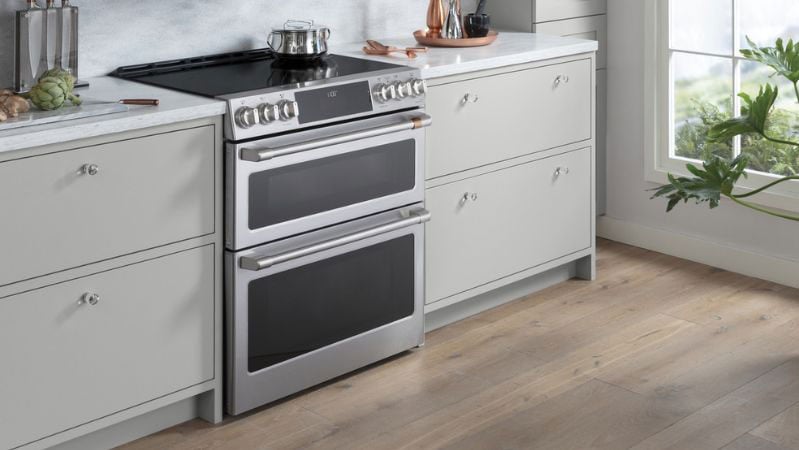
This is one of the most common issues we see. A homeowner orders a new slide-in range, only to find it doesn’t fit the opening.
Slide-ins are designed to overlap the countertop. That means the stone may need to be notched on both sides to accommodate the cooktop lip.
You will also need to remove the piece of counter behind the range so it can sit flush against the wall.
This is precision work. With granite, quartz, or other stone, the cuts need to be exact. Otherwise, you risk cracks, gaps, or damage.
How Do You Replace a Drop-In Range?
That depends on the width of your current unit.
If it is 30 inches, the job is simple. You remove the cabinet underneath, switch out the hardwired connection for a standard outlet, and drop in a freestanding or front control model.
If it is a 27-inch unit, it’s more complicated, and your options are limited:
- Replace it with another 27-inch drop-in. GE is the only brand that still makes them.
- Widen the opening to fit a 30-inch standard range. This may not be possible in tight kitchens.
- Remodel the surrounding cabinetry if you want to upgrade and cannot adjust the space.
How Do You Cut Granite?
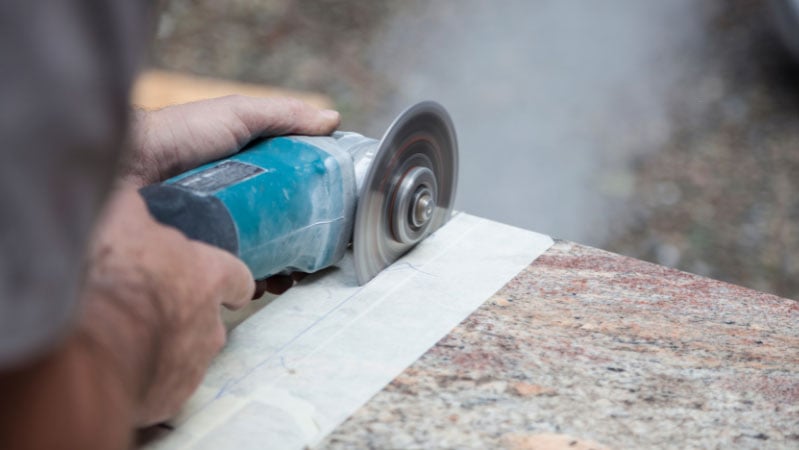
Carefully, and only with the right tools and training.
You need a countertop specialist who knows how to contain the dust and protect the surrounding area.
At Yale, our installation teams do this kind of work every day in homes from Boston to Barnstable.
We use plastic containment sheeting and high-powered vacuums to keep granite dust from spreading through your home.
If you live outside our service area, make sure your appliance dealer or installer offers the same level of care.
Cutting stone without containment can ruin furniture, HVAC systems, and electronics in just one appointment.
Why Is Range Installation So Hard to Find?
Installation demand has exploded in recent years. But most contractors avoid appliance work.
They do not want the liability of cutting stone or modifying cabinets for a single appliance.
That is one reason why our installation department has become the second largest division at Yale. We built it because no one else wanted to do it right.
That is one reason why our installation department has become the second largest division at Yale. We built it because no one else wanted to do it right.Final Verdict: Choosing the Best Range for Your Kitchen & Budget
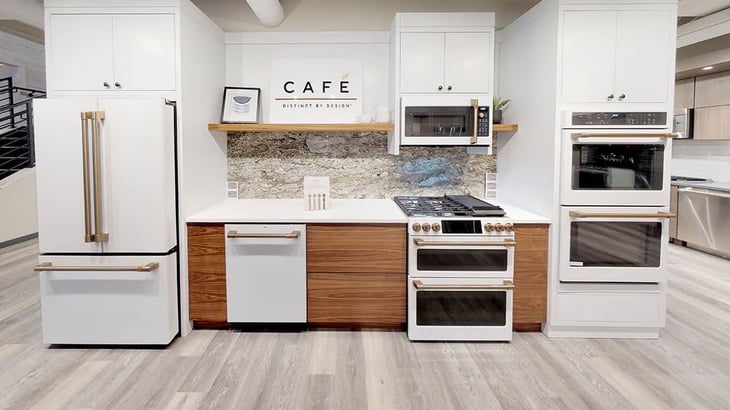
The right range depends on your layout, your style, and how much you are willing to change during the remodel.
If you are replacing an older range and want something simple that looks better, a front control range is usually the best choice.
It fits in the same space without cutting countertops or moving cabinets.
If you are building a new kitchen and want the cleanest possible look, a slide-in range gives you that seamless finish.
There are no gaps on the sides, no backguard to block your backsplash, and cleaning is easier.
Freestanding ranges are still the most budget-friendly option.
For between $800 and $1,200, you can get features like convection, five burners, and high-output power without touching your cabinets.
If you want a wall oven and cooktop instead, expect to spend between $1,700 and $8,000. Most homeowners spend around $5,500 for both.
Here is the quick breakdown:
- First-time buyers, builders, and rental owners should look at freestanding and front control models.
- If you just renovated your kitchen and want a clean design with no visible seams, slide-in and front control ranges are your best bet.
- Just remember, the difference between slide-in and front control ranges is the installation. You do not want to find that out on delivery day.
FAQs
Answers to the most commonly asked questions about changing from a freestanding range to a slide-in range and vice versa.
I currently have a freestanding range, but I want a slide-in. Will a slide-in fit into my cabinet opening?
When switching to a slide-in range, there is about a 2" space behind the range. You must either find a way to install a piece of countertop behind your range or purchase a metal filler strip that will fill this gap.
If you try to install a slide-in range without this filler strip, you will see a hole behind your range.
A Samsung slide-in range comes with a back filler.
You may have to notch the countertop so the range can "slide-in" Each one is different.
Pro design tip: When replacing an old freestanding with a slide-in or front control, look behind the backsplash. You may have to also replace the old tile behind it.
I currently have a slide-in range, but can I replace it with a freestanding range?
When switching from a slide-in range to a freestanding range, chances are you have a piece of countertop behind your range. You must have this piece of countertop removed before you install your freestanding range.
If you install a freestanding range ins a slide-in installation, chances are you will see a large gap behind the backguard of the range.
The unit will be pushed into the kitchen by a couple of inches as well.
Are slide-in ranges more expensive?
Slide-in and front control ranges are usually 30-40% more expensive than freestanding ranges with similar features.
Additional Resources
Want to learn more about the latest gas ranges and technology? Read the Yale Gas Cooking Buying Guide with features, specs and detailed profiles of every major brand. Well over 800,000 people have downloaded a Yale Guide.
Related Articles:
- The Ultimate Guide to Buying a Kitchen Range
- Most Reliable Freestanding and Slide-in Ranges
- Best Freestanding and Slide-in Gas Ranges
Recent Posts
Why Should You Trust Us?
It seems that every appliance review has nothing but glowing comments about almost every product, yet you read customer reviews and they are almost universally bad.
We are here to fill in the disconnect. We'll give you the best features, and the drawbacks as well, including reliability based on over 37,000 calls performed by our service team just last year. Our goal is to give you ALL the information so you know what's right for you.
Please consider subscribing or adding to the conversation in the comments below. We appreciate you stopping by.
Steve Sheinkopf is the third-generation CEO of Yale Appliance and a lifelong Bostonian. He has over 38 years of experience in the appliance industry, and he is a trusted source of information for consumers on how to buy and repair appliances.
Steve has also been featured in numerous publications, including the
New York Times,
Consumer Reports,
The Boston Globe,
Bloomberg Radio, the
New York Post,
The Wall Street Journal, and
Entrepreneur, for his knowledge of how to buy appliances and appliance repair.
Steve is passionate about helping consumers find the best appliances for their needs, and he is always happy to answer questions and provide advice. He is a valuable resource for consumers who are looking for information on appliance buying, repair, and maintenance.
Despite being the worst goalie in history, Steve is a fan of the Bruins and college hockey, loves to read, and is a Peloton biker. The love of his life is his daughter, Sophie.
A Note About Pricing
Pricing on this blog is for reference only and may include time sensitive rebates. We make every attempt to provide accurate pricing at time of publishing. Please call the stores for most accurate price.



